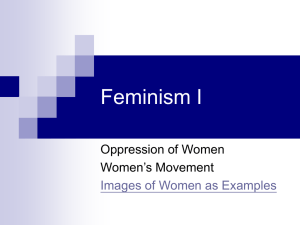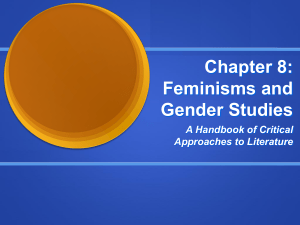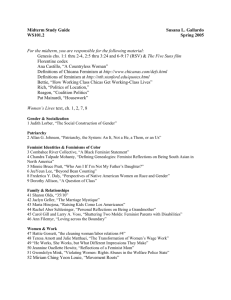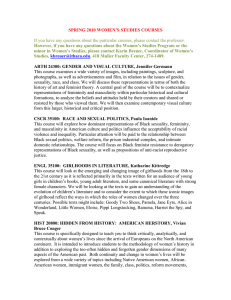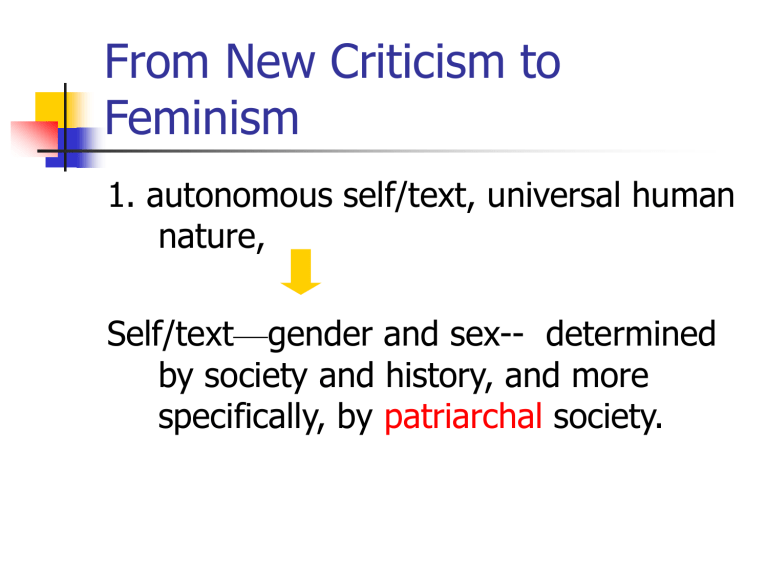
From New Criticism to
Feminism
1. autonomous self/text, universal human
nature,
Self/text—gender and sex-- determined
by society and history, and more
specifically, by patriarchal society.
Feminisms: Starting Questions
Who is feminist? Can a man be a feminist?
What are the differences between men
and women? (gender difference)
Biology--Is our body our destiny?
Personality--What is “being feminine” like?
Career Aptitude—Are there jobs unsuitable for
women?
Writing--Do men and women write differently?
Feminisms: Starting Questions(2)
Images of Women:
Are there any texts similar to “A Rose for
Emily” or “Shall I compare thee to a
summer’s day?” or 母親﹒
What are the traditional/stereotypical images
of women? What’s wrong with them?
How do women deal with those traditional
images? Rejecting them completely?
How do women look at women and women’s
images? From a man’s perspective, or a
woman’s?
Feminisms: Starting Questions(3)
Feminine Writing, Feminist writings and
Women’s work:
What is feminine writing? Does it have
definite features?
Are all women writers feminist writers?
What are the feminist strategies used in
feminist writings and cultural productions?
Feminisms: Starting Questions(4)
Body, Desire, Sexuality and Sexual
Orientation:
How do women express/liberate their desires?
Is sexual liberation the only good way? How
about body sculpture?
How do we determine our sexual orientation?
What is “good sex” and what is “bad”? (How
about S/M)
Should pornography be banned? And
prostitution be legalized?
Feminisms: focuses in class
1. women's positions in patriarchal
society and discourses (this week)
2. history of feminist movement &
writings
3. Feminisms and Gender Studies:
Radical Feminism, French Feminism,
Post-Feminism, Lesbian Feminism,
Taiwanese Feminisms
What is patriarchy?
1. male domination and limitation of women
in society;
2. male superiority in ideologies (e.g. Aristotle
declared that "the female is female by virtue
of a certain lack of qualities"; St. Thomas
Aquinas:woman is an ‘imperfect man’;
Confucius)
3. in language and literature (e.g. chairman,
the universal "he"; God as "He"; in Chinese:
妒、姦、妙、佞, etc.
4. in sex and biology (women as rapable,
receptacle of sperm)
Male Dominance in Literature
Predominance of male writers
Women limited to writing in certain genres
(e.g. diary, letter, romance).
Stereotypical presentation of women
Male Dominance in Literature
Objectifications of Women – Angel or Whore
1. Stereotyping
Idealization;
Degradation
Male Dominance in Literature (2):
Images of Women
1) as objects of desire--e.g. "Araby," "La Belle
Dame Sans Merci" "To His Coy Mistress" and
courtly love poetry, “Shall I Compare Thee to a
Summer’s Day?”
2) as symbol--"Young Goodman Brown," "Grecian
Urn" "To Autumn"
3) as Other or Villain – Snow White’s Stepmother;
Fatal Attraction
4) women inferior or subordinate--Eve, romance
(knight and lady), 007 films and the other
Hollywood films (Working Girl, Coma, Silence of
the Lamb)
Male Dominance in the Other
Cultural Products
Classical Nude Paintings
Hollywood Films
(contemporary ambivalent ones: Switch)
Music videos
Commercials, advertisement
Ways of Seeing by J. Berger
nudity is a sign, different from being
naked.
The nude in traditional oil paintings
either look at "us" (the spectatorowners in the past) or look at the mirror
The nude shows signs of
submissiveness (e.g. being languid,
passive and thus available).
Dream World (on music videos)
Who gets to tell the story about sexuality in
music videos?
Roles of women: musicians, back-up singers,
dancers, part of the story, subject of the song.
Main functions: to be looked at, decorative
Behavior: always sexually aroused and active;
nyphomaniac
Activities: getting in and out of clothes;
available for peeping.
Even female artists are trapped by this male
way of looking at women.
Is this ad an
objectification of
woman’s body?
Does this ad present
an active woman,
contrary to traditional
stereotypes?
“The Female Body”
“The female body has many uses. It’s
been used as a door-knocker, a bottleopener, as a clock with a ticking belly,
as something to hold up lampshades, as
a nutcracker, just squeeze the brass
legs together and out comes your
nut. . . . “ Margaret Atwood

